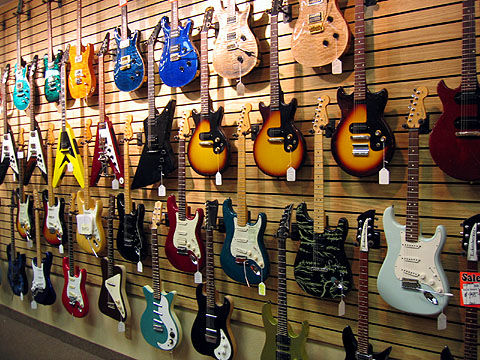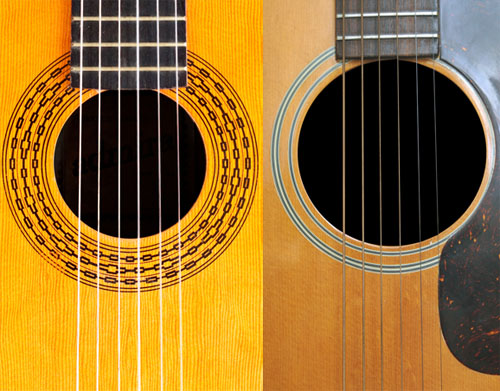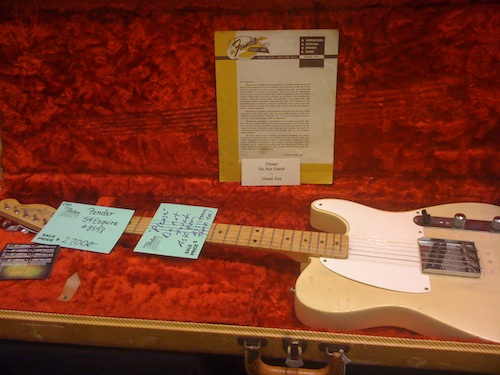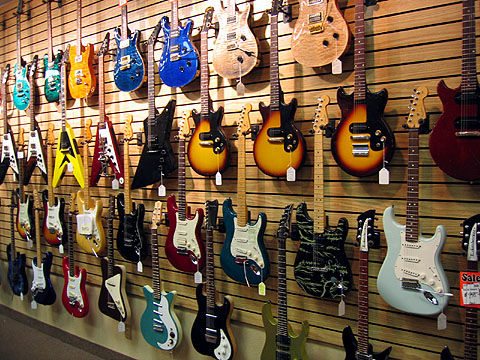Guitar tone is one of the most complex things most guitarists will have to deal with. There are plenty of guitarists that want to look at a guitar and make a blanket assumption about the sound (or ‘tone’) it produces.
The truth is that the amp and settings are always more important than the guitar itself for creating sound! Today we’re going to discuss the ways in which the guitar itself does affect the tone, and use ear training MP3s to demonstrate the sounds.
Before we dive in – how big an impact do the amp and settings really have? The following example is the same guitar and the same equipment, just with the settings altered. You’ll hear that there’s a lot of tone variation possible without changing the equipment itself.
Warning: Some of the tracks on this page have loud distorted sections – do not turn your volume up too high, especially if listening on headphones!
Electric Guitars
When it comes down to the guitar itself, the most noticeable difference is going to be the type of pickups on the guitar. Most other aspects of the tone of a guitar can be adjusted or compensated for with the right equalizer adjustments (see the Frequency Fundamentals course for more information), and those are subjective tone differences.

Electric Guitar - Listen for the different types of pickup
The 60Hz hum created by single coil pickups, on the other hand, can be a desirable or undesirable component to the tone. The entire reason the humbucker was designed was to eliminate that 60Hz hum. The following examples consist of the A Minor scale being played with a humbucker and then with a single coil pickup. Each one has progressively more distortion added to the tone:
The most obvious difference is the single coil pickup does not have as much crunch when distorted. A humbucker needs two coils to function properly, which gives it more power. If you pay close attention, you will hear the 60Hz hum in the background when the single coil is being used. It is generally not too big of an issue on a recording, where levels are kept moderate. The volume used for live performance is quite different from recording though, and a heavily distorted 100-watt amp can produce aggravating amounts of hum with a single coil pickup in a concert setting.
Acoustic Guitars
Acoustic guitars are mainly divided between “classical” guitars and “steel string” guitars. At the most basic level, these are basically the same instrument. Classical and steel string guitars use the same principles to create and project sound.

Acoustic Guitars: 'Classical' (left) and 'Steel-String' (right)
The minor differences in construction, such as the slight increase in the neck width of a classical guitar, do not make much difference to the tone. The different type of strings used on each are what do affect the tone strongly. The high tension steel strings give a much crisper note. The lower tension strings on the classical guitar give a softer tone. The examples below are a steel string guitar and a classical guitar playing the A minor scale.
Vintage Guitar Tone
There are many people that believe that a vintage guitar, either a specific model or in general, sounds better than new guitars. Vintage guitars can sell for huge sums of money compared with even ‘top of the line’ modern guitars, and some people will claim it’s because vintage guitars just sound better than modern guitars.
This is, to some extent, a placebo effect.

A vintage Fender guitar selling for $27,000 - would you hear the difference? (Photo: 3rdparty/Flickr)
I’ll explain with an analogy: Stradivarius violins are almost universally recognized as the best violins out there. However, they regularly lose in blind tests against modern-made violins, in terms of sound quality. Stradivarius violins sound better because people think they sound better! Christian Tetzlaff switched from using a Stradivarius to a modern violin, and no one noticed until he explicitly mentioned it. They are some of the best made violins in the world, but there is nothing that “magically” makes them better.
The same applies to vintage guitars. There is no magical “vintage” tone. A high quality guitar sounds like a high quality guitar, regardless of age. Certain guitars from the vintage era were particularly good, and these are still particularly good. But the same is true of many modern guitars. Don’t let anyone tell you otherwise!
Practise Listening
Now you know the basics of guitar tone – make sure you listen out for the type of guitar used on recordings in future. When you see a live band, try to consciously pay attention to the guitar being played and the tone it generates. You might be surprised at the variety of sounds an artist manages to produce with a single guitar! Try to separate the sound of the guitar from the sound of the amplifier or audio effects being used.
Any questions? Want us to cover specific aspects of guitar tone in future articles? Let us know in the comments below or our ear training forum.








Quite nicely introduced various guitar tone details! I'm pretty much satisfied reading out this post and most importantly I'm learning guitar, so this post suggestions are very much helpful to deal with my guitar playing. Thanks.